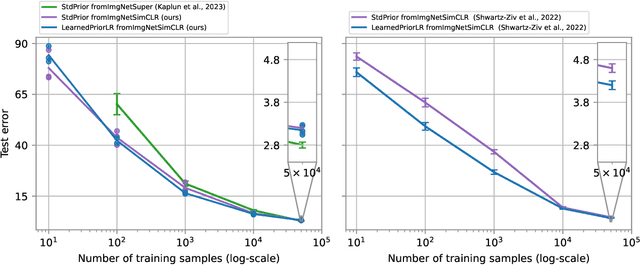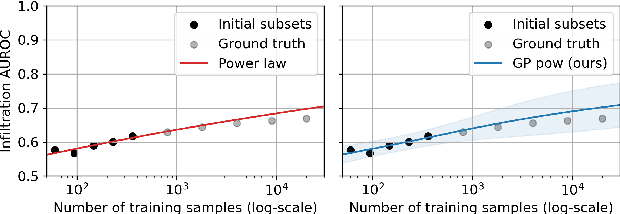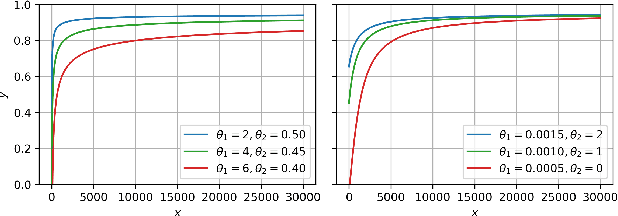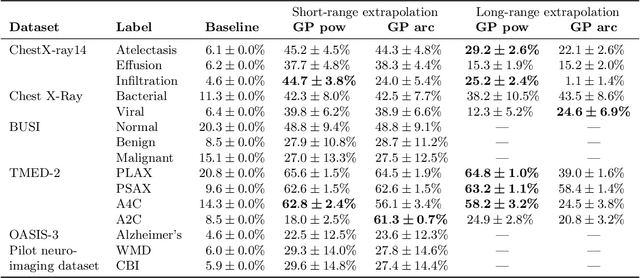Ethan Harvey
Learning Hyperparameters via a Data-Emphasized Variational Objective
Feb 03, 2025



Abstract:When training large flexible models, practitioners often rely on grid search to select hyperparameters that control over-fitting. This grid search has several disadvantages: the search is computationally expensive, requires carving out a validation set that reduces the available data for training, and requires users to specify candidate values. In this paper, we propose an alternative: directly learning regularization hyperparameters on the full training set via the evidence lower bound ("ELBo") objective from variational methods. For deep neural networks with millions of parameters, we recommend a modified ELBo that upweights the influence of the data likelihood relative to the prior. Our proposed technique overcomes all three disadvantages of grid search. In a case study on transfer learning of image classifiers, we show how our method reduces the 88+ hour grid search of past work to under 3 hours while delivering comparable accuracy. We further demonstrate how our approach enables efficient yet accurate approximations of Gaussian processes with learnable length-scale kernels.
Learning the Regularization Strength for Deep Fine-Tuning via a Data-Emphasized Variational Objective
Oct 25, 2024



Abstract:A number of popular transfer learning methods rely on grid search to select regularization hyperparameters that control over-fitting. This grid search requirement has several key disadvantages: the search is computationally expensive, requires carving out a validation set that reduces the size of available data for model training, and requires practitioners to specify candidate values. In this paper, we propose an alternative to grid search: directly learning regularization hyperparameters on the full training set via model selection techniques based on the evidence lower bound ("ELBo") objective from variational methods. For deep neural networks with millions of parameters, we specifically recommend a modified ELBo that upweights the influence of the data likelihood relative to the prior while remaining a valid bound on the evidence for Bayesian model selection. Our proposed technique overcomes all three disadvantages of grid search. We demonstrate effectiveness on image classification tasks on several datasets, yielding heldout accuracy comparable to existing approaches with far less compute time.
Transfer Learning with Informative Priors: Simple Baselines Better than Previously Reported
May 24, 2024



Abstract:We pursue transfer learning to improve classifier accuracy on a target task with few labeled examples available for training. Recent work suggests that using a source task to learn a prior distribution over neural net weights, not just an initialization, can boost target task performance. In this study, we carefully compare transfer learning with and without source task informed priors across 5 datasets. We find that standard transfer learning informed by an initialization only performs far better than reported in previous comparisons. The relative gains of methods using informative priors over standard transfer learning vary in magnitude across datasets. For the scenario of 5-300 examples per class, we find negative or negligible gains on 2 datasets, modest gains (between 1.5-3 points of accuracy) on 2 other datasets, and substantial gains (>8 points) on one dataset. Among methods using informative priors, we find that an isotropic covariance appears competitive with learned low-rank covariance matrix while being substantially simpler to understand and tune. Further analysis suggests that the mechanistic justification for informed priors -- hypothesized improved alignment between train and test loss landscapes -- is not consistently supported due to high variability in empirical landscapes. We release code to allow independent reproduction of all experiments.
A Probabilistic Method to Predict Classifier Accuracy on Larger Datasets given Small Pilot Data
Nov 29, 2023



Abstract:Practitioners building classifiers often start with a smaller pilot dataset and plan to grow to larger data in the near future. Such projects need a toolkit for extrapolating how much classifier accuracy may improve from a 2x, 10x, or 50x increase in data size. While existing work has focused on finding a single "best-fit" curve using various functional forms like power laws, we argue that modeling and assessing the uncertainty of predictions is critical yet has seen less attention. In this paper, we propose a Gaussian process model to obtain probabilistic extrapolations of accuracy or similar performance metrics as dataset size increases. We evaluate our approach in terms of error, likelihood, and coverage across six datasets. Though we focus on medical tasks and image modalities, our open source approach generalizes to any kind of classifier.
A Comparative Analysis of Machine Learning Models for Early Detection of Hospital-Acquired Infections
Nov 15, 2023



Abstract:As more and more infection-specific machine learning models are developed and planned for clinical deployment, simultaneously running predictions from different models may provide overlapping or even conflicting information. It is important to understand the concordance and behavior of parallel models in deployment. In this study, we focus on two models for the early detection of hospital-acquired infections (HAIs): 1) the Infection Risk Index (IRI) and 2) the Ventilator-Associated Pneumonia (VAP) prediction model. The IRI model was built to predict all HAIs, whereas the VAP model identifies patients at risk of developing ventilator-associated pneumonia. These models could make important improvements in patient outcomes and hospital management of infections through early detection of infections and in turn, enable early interventions. The two models vary in terms of infection label definition, cohort selection, and prediction schema. In this work, we present a comparative analysis between the two models to characterize concordances and confusions in predicting HAIs by these models. The learnings from this study will provide important findings for how to deploy multiple concurrent disease-specific models in the future.
 Add to Chrome
Add to Chrome Add to Firefox
Add to Firefox Add to Edge
Add to Edge